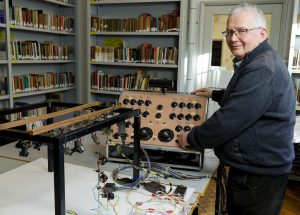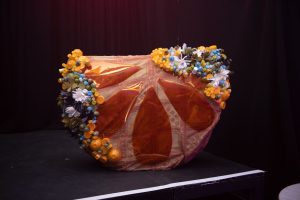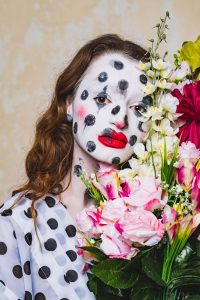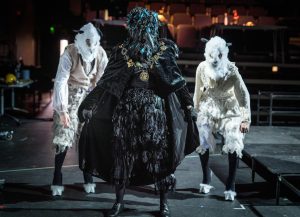In January 2023, Keith McLaren, the depositor of the Miniature Stage Lighting visited the Theatre Collection to show us how the Miniature Stage Lighting worked and to give an insight into how the equipment could be used.
The Miniature Stage Lighting was deposited in October 2022 and has been catalogued as BTC334 Miniature Stage Lighting. It is equipment designed and made by Robert Stanbury who taught stage lighting to theatre design students at the Wimbledon College of Art in the late 1950s until the mid-1960s. He also made equipment for people including the eminent lighting designers Michael Northen and Richard Pilbrow and companies such as the D’Oyly Carte Opera Company. This particular equipment was ordered by Rae Hammond who was General Manager of the Everyman Theatre, Cheltenham and is generally for use with 1:24 theatre design models although the equipment is larger for practical reasons. The lighting includes a control desk and several luminaires.
I worked with a colleague who took photographs of the individual parts and the process of setting them up for use. I took notes of the steps and advice, and I am creating a guide for future staff to use the equipment. We hope that our work will enable future generations to access and use the Miniature Stage Lighting in an informed way.
The process included building the stand, connecting the control desk to the mains, and connecting the luminaires to the control desk. Trial and error were needed such as to find out which lamp was connected to which dial on the control desk and the depositor gave us advice about common problems. Some of these included wires touching the body of the lamp and dirty contacts (the parts on the control desk used to assign a lamp to the left or right control dial).
I originally invited Keith to the session thinking that we would light a set model. However, he said he found this idea interesting because you don’t generally aim to light the set directly, apart from possibly motivating light (sunlight, moonlight etc.), rather relying on incidental “bounce light” from actor light. We ran out of time anyway!
The Theatre Collection also holds other items relating to lighting including collections such as BTC 155 Michael Northern Collection. Michael Northen (1921 – 2001) was the first credited Lighting Designer in the UK and his work on “The Mousetrap” can still be seen in the West End today. The JD Joe Davis Archive contains the archive of Lighting Designer Joe Davis (1912 – 1984). There is also a Mander & Mitchenson Collection reference box for lighting & sound. In addition, individual items such as lighting plots, plans and diagrams can be found within many of the other collections held at the Theatre Collection and there is a lighting section in the Theatre Collection library.
If you have archives relating to lighting (or any other aspect of professional British theatre or live art) that you would be interested in donating, please have a look at our ‘finding a home for your records’ page. You may also be interested in finding out more about caring for your records.
If you are interested in finding out more about theatre lighting, then please have a look at our catalogue and read more about visiting us.




